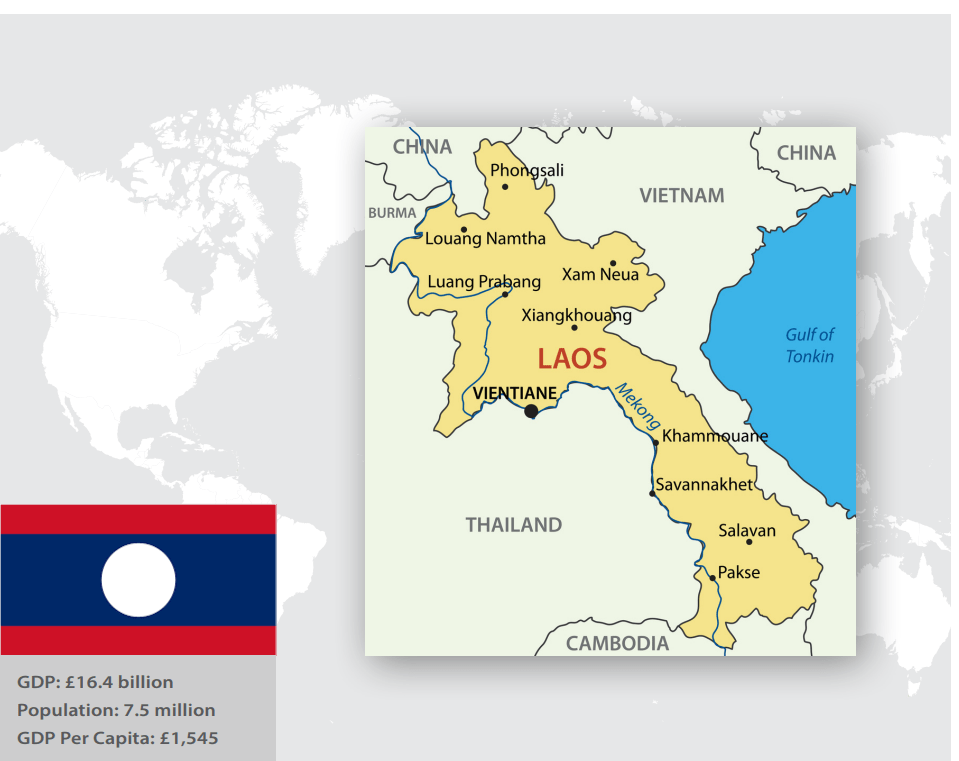AUTHOR: Pitamber Kaushik works as a freelance writer and journalist. His articles have previously been featured in publications such as Asia Times, The Hindu, The Telegraph, Gulf News, South Asia Monitor, Brussels Times, Helsinki Times, and The New Delhi Times. His essays have been featured in a variety of publications during the last six months, including, Asia Times, Cultural Daily, Business Manager Magazine, The Business Standard, Eurasia Review, Unsustainable Magazine, Business Review Afrika, Punjab Today, e-architect Magazine, Baltic Review, and Africa Business Magazine.

The small, landlocked Southeast Asian nation of Laos shares borders with Vietnam, Cambodia, Thailand, Myanmar, and China. In spite of being a humble economy, Laos could prove to be a crucial strategic bastion for India for multiple economic, geopolitical, strategic, and sociocultural reasons.
Laos is a resource-rich country, with significant deposits of minerals, including gold, copper, and coal, as well as abundant natural resources, including forests and water resources. Moreover, Laos is strategically located along the Mekong River, which provides an important trade route connecting Southeast Asia with China. India could benefit from Laos’s plentiful natural resources, as well as from its position along the Mekong River, by investing in infrastructure projects, such as roads, ports, and railways, to improve connectivity and trade between the two countries. The country’s large resource reserves and strategic location make it an attractive destination for foreign investment. India could leverage this growth potential by investing in infrastructure development, particularly in the areas of energy, transportation, and communication. India’s expertise in these areas could also help Laos to overcome some of the persistent logistical and infrastructural challenges it faces, such as poor road networks and limited electricity supply. India’s extensive experience with hydropower would prove pertinent in helping harness the country’s immense hydel potential. It is vital for India to gain the first-mover advantage in such sectors and consolidate its presence by investing in the creation of the fundamental infrastructure of the country which would yield both nations immense long-term benefits. As Laos gradually opens its cloistered market and eases trade and business restrictions, it offers a promising opportunity for both the Indian government as well as Indian companies to leverage their developmental experience to transform the sequestered economy by laying out fundamental infrastructure, providing vital technical knowhow, streamlining resource utilization, and creating innovative grassroots developmental solutions. India could prove instrumental in the country’s recovery from its pandemic slump by lending its expertise in fostering the development of medium and small enterprises which constitute the bulk of the country’s economy. In the past decade, India has used policy interventions, incentivization, and digital facilitation to promote impressive grassroots economic development and revitalize its economy. India can help Laos formulate government initiatives that provide a stable facilitative policy framework for businesses and enterprises to open and grow, create robust extensive digital infrastructure to ensure convenience and connectivity, and simplify, rationalize, and contextualize regulations to stimulate economic activity. Indian enterprises can help the country modernize and systematize its mining and agricultural sectors, avail affordable and accessible telecommunication services, and provide a symbiotic milieu of varied digital services, helping Laos return to its former track of economic ascent. Currently, Laos has a high debt dependency on China, having half of its debt due to the ambitious, expansionist superpower notorious for its record of enticing, manipulating, strategically coercing, and ultimately capsizing small, developing economies in the Global South by means of debt traps. Various international agencies, intergovernmental bodies, and experts have expressed concerns over Laos’s debt structure and pattern of borrowing. Laos needs to look no further than the recent victim Sri Lanka whose economy is collapsing under the burden of Chinese credit. Laos could thus seek a far more benevolent and beneficent lender in India, a benign democracy, a development-focused nation, and a gentle giant that doesn’t have direct imperial interests in the country.
Laos is located in the heart of Southeast Asia and shares borders with five nations, making it an important geopolitical player in the region. India has been seeking to expand its influence in Southeast Asia as part of its “Act East” policy, and Laos could serve as a gateway for India to increase its presence in the region. Laos has traditionally had close ties with Vietnam, which could also prove advantageous to India in its efforts to deepen its engagement with Vietnam, a crucial ally in its geopolitical tug-of-war with China. Developing infrastructure in Laos would also provide India the benefit of adroitly manifesting its presence along a central stretch of the Mekong River, the lifeline of Southeast Asia, yielding key strategic, tactical, logistic, and resource benefits. Although Laos does not border any sea or ocean, its ensconced location makes it a secure bastion in proximity to China with the relatively stable and neutral states of Vietnam, Cambodia, and Thailand providing a political buffer, lowering risks of conflict. The presence of a shared vital river basin further lowers the risk of intrusion, assault, or sabotage attempts by China. Laos shares a relatively small but strategically important border with China and India’s establishment of a diplomatic and economic stronghold in the country would help it keep a closer watch over the southeastern frontiers of its archnemesis.
Laos has traditionally maintained a neutral foreign policy, which makes it a valuable partner for India as it seeks to balance its relationships with other countries in the region, such as China and the United States. In addition, Laos is a member of the Association of Southeast Asian Nations (ASEAN), which gives India an opportunity to engage with other member states and participate in regional forums. India and Laos could work together to promote regional stability and advance shared interests such as economic development, energy security, and environmental sustainability. It is favorable for Laos to accept India as a trustworthy strategic economic partner for several reasons. India and Laos both have a colonial past and investments and undertakings by India are likely to be viewed less suspiciously than those by former imperial-colonial powers. India’s economic journey is essentially a stepwise transition from a quasi-socialist, quasi-closed market to a liberalizing economy and open market. Laos, a socialist nation, is hesitantly looking at a similar gradual economic transition. India has gone through decades of struggle with stagflation and could utilize its experience and policy insights to help streamline and stabilize the rather precarious trajectory of Laos’s economic development. Further, India enjoys the convenient middle ground of being a fellow developing Asian nation in relative geographical and cultural proximity to Laos without being its direct neighbor. This could enable it to enjoy the significant familiarity and elicit trust from the country while also avoiding competing interests and averting suspicions of undue influence or imperial motives which, for instance, would naturally arise with neighbor China.
Laos is a multi-ethnic country with a rich cultural heritage. India and Laos share historical and cultural ties, which could serve as a foundation for strengthening bilateral relations. For example, Buddhism is the predominant religion in Laos, India could leverage its status as the origin of Buddhism and its key pilgrimage sites to deepen cultural exchanges and promote people-to-people contacts between the two countries. India could also share its experience in education, healthcare, and tourism to help Laos develop its human capital and promote sustainable economic growth. By fostering intellectual and cultural exchange, India could further its soft power and ideological interests in the country and subsequently the region.
Laos is unique among Southeast Asian nations because of its relative isolation from the rest of the region, its rugged terrain, and its small population. Laos has a distinct cultural identity and has historically been non-partisan and relatively inert in its international relations, which has allowed it to avoid being drawn into conflicts between more extensive powers in the region. Despite its small size, Laos has played an active role in regional diplomacy, particularly as a member of ASEAN.
Although Vietnam, Thailand, and Cambodia are also important partners for India in Southeast Asia, Laos has several unique advantages over these countries. First, Laos is located at the heart of the region, which gives India a strategic foothold in Southeast Asia in its pursuit to expand its presence in the region. Second, Laos has almost consistently maintained a neutral foreign policy over the greater part of its history and has thus far been relatively insulated from foreign influence, making it opportune for a prompt congenial approach and gradual conditioning as an ally to India. Finally, Laos has abundant natural resources, including minerals and water resources, which could be of significant economic benefit to India. As Laos struggles with rising inflation and slowing growth, Indian investments could revive the country’s cloistered economy. Undertaking investments and projects in Laos would afford India a fresh geostrategic vantage point as well as novel perspectives and mutualistic experiences of socioeconomic development. For Laos, India, a stable and peaceful Asian regional superpower that doesn’t have direct geopolitical interests in the region could prove to be a multidimensional mentor and patron, a non-intrusive development ignitor that could bring out the recluse state from its long-time developmental stasis and its protracted recent economic crises.
*“The views expressed in the article are author’s personal and are not endorsed by the Global Policy Consortium (GPC) or assumed by their members”
